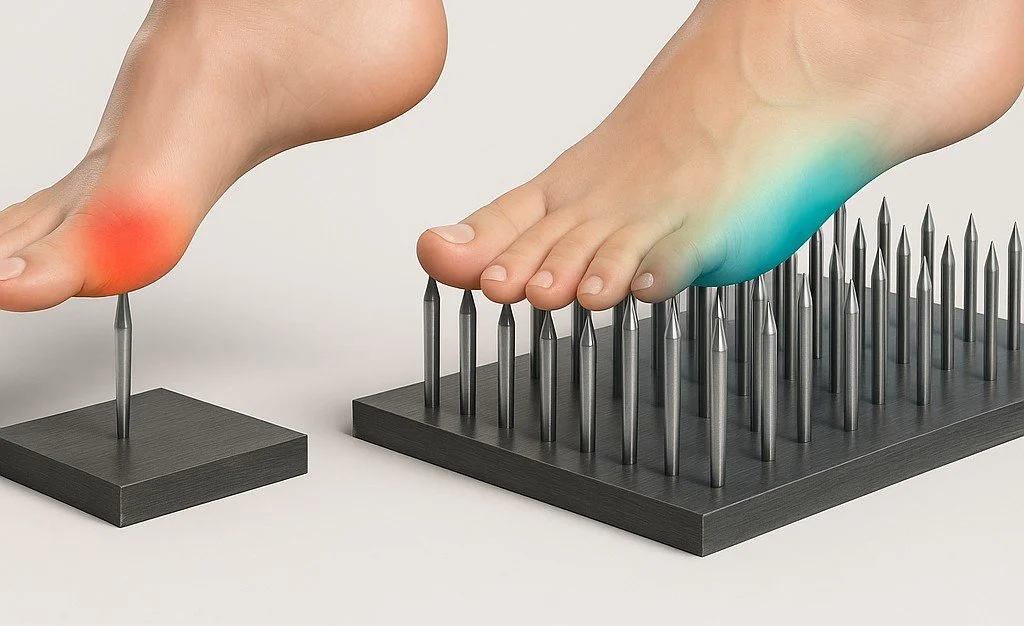Pressure, Force vs Tactile Explained
How pressure mapping drives smarter design
Pressure shapes our world in ways we rarely notice. It keeps jets aloft, makes glasses rest comfortably on your face, and determines whether a robotic gripper handles a delicate component with precision or crushes it outright. Here, Dr. Jae Son, CEO and founder of PPS, explains the science behind pressure and force, and shows how tactile pressure mapping transforms invisible interactions into actionable data for smarter design.
The invisible distinction: Pressure vs Force
Which one do you think will hurt more? Standing on one nail or on a board of many. It’s all about pressure distribution…
The difference between pressure and force is subtle but fundamental. Confusing them can be costly in fields where safety, comfort, and precision matter.
Force is how much push or pull is applied in a specific direction (a vector), and pressure is how that force is distributed over an area (a scalar).
A scale illustrates this well: it measures your weight (force due to gravity). If you take the same scale to the Moon, and the reading drops it’s not because you changed, but because the gravitational force is weaker.
Pressure adds another layer. Imagine standing barefoot on a smooth floor: the force is spread evenly, and it feels fine. But standing on a pebble using the same force, but concentrated into a small area, causes pain. The difference between standing barefoot on a smooth floor or on a pebble comes down to how pressure works in everyday life, it’s the same force, but concentrated into a smaller area.
This principle explains why:
A blood pressure cuff at just 3 psi feels painful, while being underwater at 10 meters (nearly 15 psi) feels fine. In the same way, a restaurant table can wobble even if its legs are the same length because the contact mechanics of the floor and leg create uneven pressure.
Why force and pressure alone aren’t enough
Traditional sensors measure force or pressure as single values. But the real world is rarely uniform. Loads shift, surfaces deform, and contact points matter.
This is where tactile sensing comes in. Tactile sensors don’t just tell you “how much,” they reveal where and how that force is distributed by producing two-dimensional pressure maps over time.
Force sensors → “How much, in which direction”
Pressure sensors → “How much, overall”
Tactile sensors → “How much and how it is distributed over a surface”
At PPS, capacitive array sensors deliver high-resolution, time-resolved maps that show exactly how loads are applied and shift, revealing dynamics that single values miss.
From data to actionable insights
Pressure maps unlock critical metrics, including total force, the overall load applied, and the centre of force, which represents the balance point of that load.
These insights have wide applications across multiple industries. For example, in motorsport, tire pressure distribution can mean the difference between perfect grip and dangerous skidding. In healthcare, beds and wheelchairs can be designed to minimize pressure points to prevent discomfort and injury. In ergonomics, understanding ergonomic product design and human comfort is essential for creating products like glasses or shoes that require long-term wear.
Same force, different outcomes
Force-only measurements can be misleading. Consider two robotic grippers applying the same grip force. A narrow pad concentrates the pressure, risking damage or slippage, whereas a wide pad distributes the load, ensuring a secure, gentle hold.
Force readings alone may suggest identical performance, but tactile pressure mapping reveals the difference. This enables robots to handle fragile objects such as microchips and fresh produce without the guesswork of trial-and-error.
Ensuring reliability
Precise tactile data depends on calibration. Real-world conditions, namely surface curvature, material compliance, and the environment, affect how pressure is distributed. Calibrating sensors in context ensures measurements are reliable, repeatable, and relevant.
Force tells us how much and which way. Pressure tells us how much per area. Tactile sensing tells us where and how it changes over space.
By revealing this full picture, tactile pressure mapping enables smarter, safer, and more efficient designs across industries, from robotics and healthcare to aerospace and consumer products.


